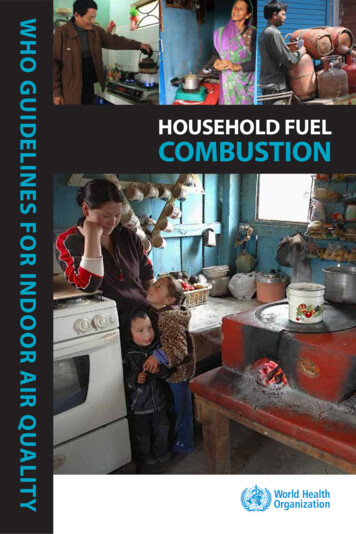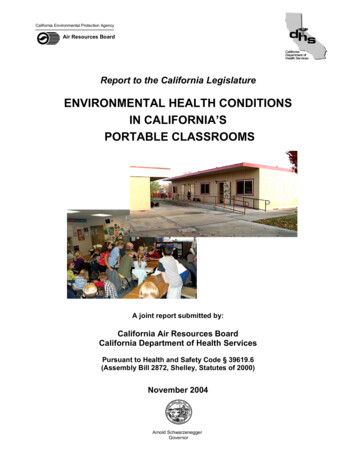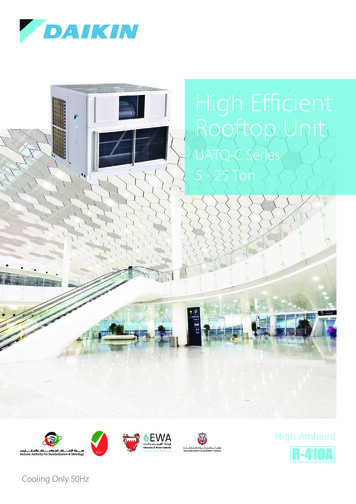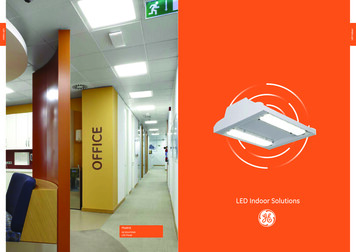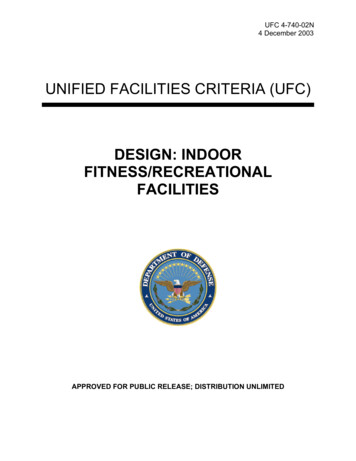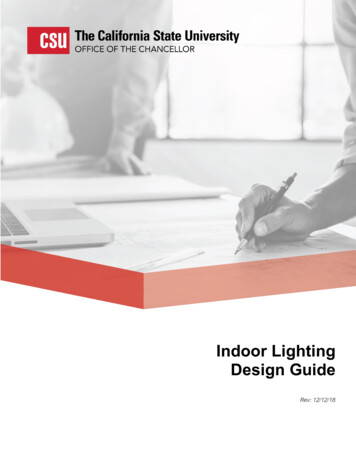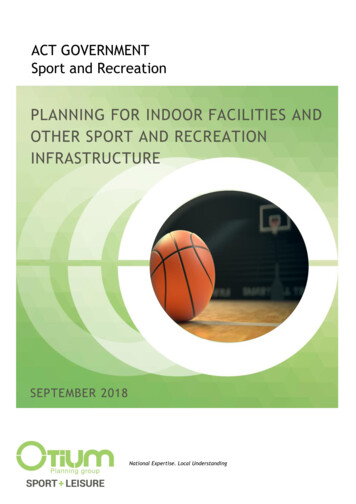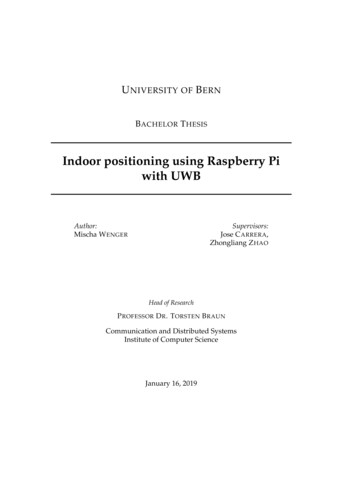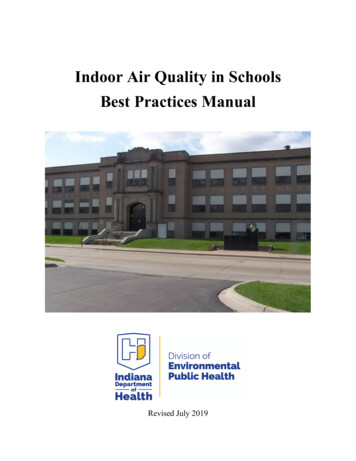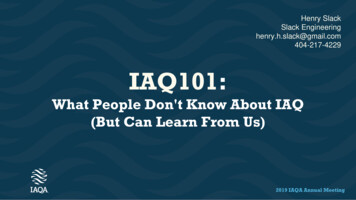
Transcription
Henry SlackSlack 01:What People Don't Know About IAQ(But Can Learn From Us)2019 IAQA Annual Meeting
Acknowledgements Dr. Richard Shaughnessy Terry Brennan Bob Axelrad, Laura Kolb, BarbaraSpark, Larainne Kohler, TobieBernstein, Tim Wallace, and manyothers who assisted my IAQ work atUS EPA over 27 years2019 IAQA Annual Meeting
How much air do we have?2019 IAQA Annual Meeting
2019 IAQA Annual Meeting
Does this office have an IAQproblem? Tenants report Odors Feel sick “Not right” What do you doif you are called inprofessionally?2019 IAQA Annual Meeting
2019 IAQA Annual Meeting
Since the 50’s Carpets, wallboard Particleboard,finishes, glues, foam insulation Computers, printers, copiers (toner) Cleaning, personal care, pesticidechemicals No openable windows2019 IAQA Annual Meeting
What’s In Our Air?2019 IAQA Annual Meeting
What Is It? Secondhand Smoke! Adults - lung cancer Children – asthma, bronchitis,pneumonia, ear infections, SIDS2019 IAQA Annual Meeting
What Is It? Radon! 21,000 deaths yearly2nd leading cause oflung cancerPrevent: 500- 2500TEST YOUR HOME!Fix only w/ certified2019 IAQA Annual Meeting
What Is It? Carbon Monoxide “Head” symptoms:dizzy,nausea, headache,tired, confused, flu-like Failed combustion gear,emergency powergenerators, tailpipes2019 IAQA Annual Meeting
What Are They? Volatile Organic Chemicals (VOCs) Headaches, rash, respiratory “Wet” building products,pesticides, pressed wood(formaldehyde), cleaners2019 IAQA Annual Meeting
What Are These? Biologicalcontaminants Cat dander Pollen Roach or rat droppings Dust mite droppings MoldAllergy, irritation, etc.2019 IAQA Annual Meeting
Health Effects from Biologicals Infections Contagious (colds, flu, TB, measles) Enviro-source (Legionella, Histoplasmosis, aspergillosis) Toxicoses (mycotoxins, endotoxins) Hypersensitivity Diseases Allergy, asthma, Hypersensitivity Pneumonitis (HP)2019 IAQA Annual Meeting
Legionella Not just cooling towers Grows at 70-110 FFountain, DHW line/shower, mistmachine, humidifier, spa, othersASHRAE Standard 188-18Legionella is PREVENTABLE Work practices should reflect guidance2019 IAQA Annual Meeting
EPA on Molds Popular guidance NO REGULATIONS Health Effects inAppendix B162019 IAQA Annual Meeting
Big Ideas about Molds Mold MOISTURE. Get rid of both! Sample only for legal reasons, to find hidden mold, or ifresults changes M.D.’s treatment No Federal mold standards No Federal regulations for cleanups Biocides not recommended routinely2019 IAQA Annual Meeting
Sampling Snapshot Air sampling providesinformation only for the timeof sampling Experience in interpretationof results is essential2019 IAQA Annual Meeting
Guidelines for Remediating MoldGrowth Caused by Clean Water Table 2, Page 14: EPA divides into Small ( 10 square feet) Medium (10-100 square feet) Large ( 100 square feet) Cleanup, protective equipment, andcontainment vary with size2019 IAQA Annual Meeting
What We Didn’t Cover Lead-based paint Asbestos Sewer Gases Pesticides CO22019 IAQA Annual Meeting
Outside Air affects IAQ2019 IAQA Annual Meeting
What Else? Physical factors noise lighting vibration temperature Mental factors – trust, psychosocial2019 IAQA Annual Meeting
Finding IAQ Problems Talk to occupants (esp. maintenance) Visual Assessment – look for sources IAQ “walk through” Then fix problems! Testing may beineffective May not identify sources, health concern2019 IAQA Annual Meeting
Visual Inspection Often notcomplicated2019 IAQA Annual Meeting
2019 IAQA Annual Meeting
2019 IAQA Annual Meeting
2019 IAQA Annual Meeting
On the roof2019 IAQA Annual Meeting
2019 IAQA Annual Meeting
2019 IAQA Annual Meeting
2019 IAQA Annual Meeting
2019 IAQA Annual Meeting
2019 IAQA Annual Meeting
2019 IAQA Annual Meeting
2019 IAQA Annual Meeting
Visual Inspection Tools Thermometer, RH meter Ruler, flashlight, screwdriver, knife Moisture meter Smoke, feather or micromanometer2019 IAQA Annual Meeting
What can we do for indoor air? CONTROL pollution sources If inside, cover it or replace it If outside, don’t bring it in! VENTILATE to remove/dilutepollutants CLEAN the air, whetherrecirculated or “fresh”2019 IAQA Annual Meeting
Source Control I –Keep It Out! Use low-emitting materials:paints, adhesives, carpets,wood products Use Green Cleaners – fewer VOCs/odors No Smoking! Seal ductwork, garage connections, etc. Trap dirt at doors (walk-off mats) Integrated Pest Management – less , chem2019 IAQA Annual Meeting
Source Control II –If in, control ! Cover stinky stuff – cap chemicals, wrap smelly stuff Use HEPA vacuum cleaners,floor buffers to capture particles Capture or exhaust dust or fumesfrom any other activities (hobbies, cooking)2019 IAQA Annual Meeting
ControllingMold Moisture Control KEY to Mold Control Use of antimicrobials (like bleach) not recommendedroutinely You see mold, it’s there. Do you need to sample? Solve the moisture, then remove moldy material.Discard moldy porous items.2019 IAQA Annual Meeting
Ventilation Check HVAC operation, especially outside air – may notbe working Are exhausts working? Add exhaust? Exhaust dirtiest air?Dilute with outside air? Increase OA flow?2019 IAQA Annual Meeting
Find outside air intakes Are they working? Is there damage? Change? Is a possible source nearby?2019 IAQA Annual Meeting
Cost of office ventilation Class A office space may be 15-20/sf/year Utility bills are 1-2/sf/yr HVAC is 0.40- 1/sf/yr Outdoor air is 0.05-15/sf/yr Office salaries: 200- 300/sf/yr 1% change in productivity: 2-3/sf/yr 2 0.152019 IAQA Annual Meeting
Clean or filter the air Filters – Min. Efficiency Rating Value (MERV) Office, EPA recommends MERV 8 Homes, EPA - MERV 6 Higher MERV: more , more energy,less dirt in the air and lungs “Air purifiers” can help butnot a full solution2019 IAQA Annual Meeting
Ozone not “aircleaner” Ozone lung irritant, regulated outdoors O3 reacts quickly with some chemicals and can doubleVOC levels Other chem reactions take weeks “New miracle technology” may produce O3 www.epa.gov/iaq/pdfs/ozone generator.pdf2019 IAQA Annual Meeting
Exposure Control Move people away from the problem For a day, or nightly, or more Temporary (vacation) or permanent2019 IAQA Annual Meeting
For all solutions, communicate! Let occupants know you acted Be sure they understand whatyou’re doing to fix the identifiedproblem Always follow through. Build trust2019 IAQA Annual Meeting
Future of Indoor Air Per LBNL, worst pollutant PM 2.5, then tobacco smoke,radon, and formaldehydeParticulate Matter 2.5 affects cardiovascular (elderly),unborn, babies it’s measurable“Citizen Science” (wearablemonitors) will drive news mediaLegionella: headlines andPREVENTABLE2019 IAQA Annual Meeting
Stories (if time) Odor in lobby by coffee shop Unplanned filtration Chicken restaurant2019 IAQA Annual Meeting
Conclusions Air is a slender layer over us Visual inspection is fastestway to solve problems For solutions, think Source Control Ventilation Air Cleaning2019 IAQA Annual Meeting
Bibliography www.epa.gov/iaq2019 IAQA Annual Meeting
Questions?Henry Slackhenry.h.slack@gmail.com2019 IAQA Annual Meeting
Slack Engineering henry.h.slack@gmail.com 404-217-4229 IAQ101: What People Don't Know About IAQ (But Can Learn From Us) 2019 IAQA Annual Meeting Acknowledgements Dr. Richard Shaughnessy Terry Brennan Bob Axelrad, Laura Kolb, Barbara Spark, Larainne Kohler, Tobie Bernstein, Tim Wallace, and many others who assisted my IAQ work at US EPA over 27 years. 2019 IAQA Annual Meeting How much .
